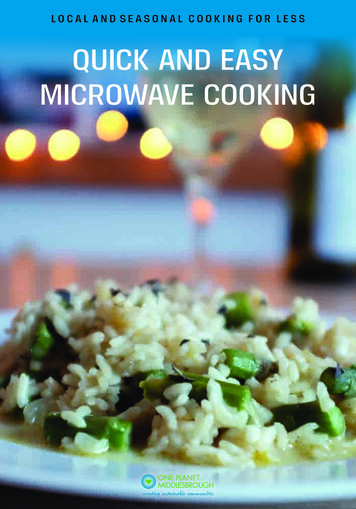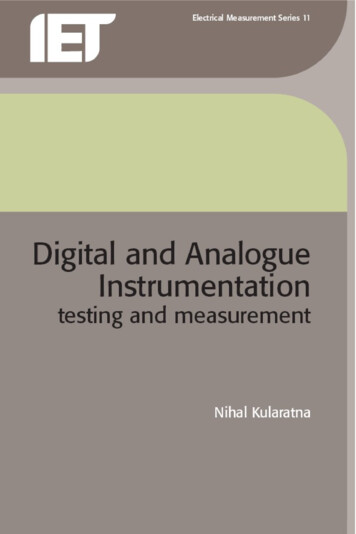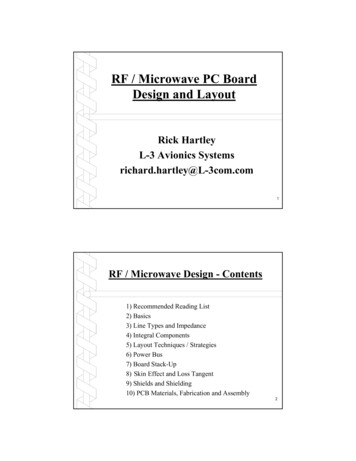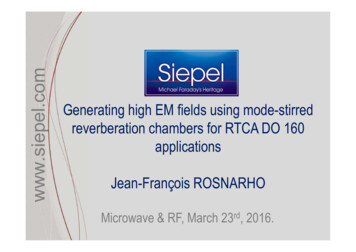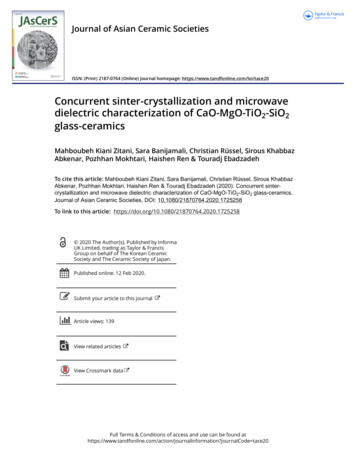
Transcription
Journal of Asian Ceramic SocietiesISSN: (Print) 2187-0764 (Online) Journal homepage: https://www.tandfonline.com/loi/tace20Concurrent sinter-crystallization and microwavedielectric characterization of CaO-MgO-TiO2-SiO2glass-ceramicsMahboubeh Kiani Zitani, Sara Banijamali, Christian Rüssel, Sirous KhabbazAbkenar, Pozhhan Mokhtari, Haishen Ren & Touradj EbadzadehTo cite this article: Mahboubeh Kiani Zitani, Sara Banijamali, Christian Rüssel, Sirous KhabbazAbkenar, Pozhhan Mokhtari, Haishen Ren & Touradj Ebadzadeh (2020): Concurrent sintercrystallization and microwave dielectric characterization of CaO-MgO-TiO2-SiO2 glass-ceramics,Journal of Asian Ceramic Societies, DOI: 10.1080/21870764.2020.1725258To link to this article: https://doi.org/10.1080/21870764.2020.1725258 2020 The Author(s). Published by InformaUK Limited, trading as Taylor & FrancisGroup on behalf of The Korean CeramicSociety and The Ceramic Society of Japan.Published online: 12 Feb 2020.Submit your article to this journalArticle views: 139View related articlesView Crossmark dataFull Terms & Conditions of access and use can be found ation?journalCode tace20
JOURNAL OF ASIAN CERAMIC 5258FULL LENGTH ARTICLEConcurrent sinter-crystallization and microwave dielectric characterization ofCaO-MgO-TiO2-SiO2 glass-ceramicsMahboubeh Kiani Zitania,b, Sara Banijamalia, Christian Rüsselb, Sirous Khabbaz Abkenarc, Pozhhan Mokhtaric,Haishen Rend and Touradj EbadzadehaaCeramic Department, Materials and Energy Research Center (MERC), Alborz, Iran; bOtto-Schott-Institut Für Material Forschung, JenaUniversity, Jena, Germany; cDepartment of Materials Science and Nano-Engineering, Sabanci University, Istanbul, Turkey; dKey Laboratoryof Inorganic Functional Material and Device, Shanghai Institute of Ceramics, Chinese Academy of Sciences, Shanghai, ChinaABSTRACTARTICLE HISTORYThe present work aims to clarify sinter-crystallization behavior and microwave dielectricfeatures of CaO-MgO-TiO2-SiO2 glass-ceramics fabricated via one-step sintering procedure at800–950 C for 4 h. In this regard, starting glasses were obtained from a conventional meltquenching technique, then subjected to the sinter-crystallization heat treatment. The crystallization behavior of sintered glass-ceramics was studied using X-ray diffraction (XRD) andelectron backscatter diffraction (EBSD). On the basis of the obtained results, diopside(CaMgSi2O6) precipitated as the main crystalline phase in all sintered glass-ceramics; howevertitanite (CaTiSiO5) was found as the secondary crystalline phase in glass-ceramics containinghigh TiO2 content. The degrees of crystallization of the glass-ceramics prepared procedureswere also characterized. Optimized glass-ceramics sintered at 800 C for 4 h showed themaximum relative density of 99%. Further increase of sintering temperature led to gradualdecrease of density. The most promising microwave dielectric properties of the sintered glassceramics were as εr 6.8–9.4 and Q f 3,735–41,359 GHz.Received 4 June 2019Accepted 30 January 20201. IntroductionDevelopment of mobile and satellite communicationdevices has greatly increased the demand for complexminiaturized circuits in microwave frequency rangeapplications. In this regard, the technology of low temperature co-fired ceramics (LTCC) has played a crucialrole to reduce the dimension of microwave circuitsowing to its integration capability of different components such as substrates, resonators and electrodesmaterials. Low sintering temperature is the key parameter of this technology to keep the consistency ofmetallic electrodes with low melting temperature (suchas silver, gold and copper) incorporated into the LTCCmodules [1–4].Glass-ceramics are well known as suitable candidates to be used as LTCC substrates in high-frequencyapplications owing to their favorable properties(including low dielectric constant, low dielectric loss,appropriate chemical durability and thermal expansioncoefficient) as well as the advantage of comparativelyeasy mass production. In the case of glass-ceramics, itis also possible to control the kind of precipitatedcrystalline phases, degree of crystallization and microstructural features by tailoring the chemical composition of starting glasses and controlling of fabricationprocess [5–7].CONTACT Mahboubeh Kiani ZitaniKEYWORDSGlass-ceramic; sintering;crystallization; diopside;titanite; dielectric propertiesAmong various silicate-based glass-ceramics, theglass-ceramics of CaO-MgO-SiO2 system are suitablecandidates for LTCC technology owing to their lowdielectric loss, excellent chemical durability as well asappropriate mechanical properties at low sinteringtemperature [7,8].Complete densification and sufficient crystallinity arethe main factors in the fabrication of desirable glassceramics used in LTCC substrates [9]. In this regard,many studies have been reported to elucidate the effectof nucleating agents and sintering aids on sinter-crystallization behavior of glass-ceramics and their correlationwith microwave dielectric characteristics [10–14].K.C. Feng et al. [14] investigated the effect of ZrO2 asa nucleating agent on crystallization, microstructureand microwave dielectric properties of CaO-MgO-SiO2glass-ceramics at low sintering temperature. The bestdielectric properties of modified CaMgSi2O8 glass-ceramics containing ZrO2 sintered at 950 C were: εr 7.03,Q f 7318 GHz.Diopside ceramics have a considerable temperaturecoefficient of resonant frequency (τf) ( 42 ppm/oC) [15].In order to achieve glass-ceramics with nearly zero τf,the presence of another crystalline phase having positive value of τf is necessary. Hence, diopside glass systems were modified by addition of TiO2 (with τf value of 400 ppm/oC [16]) to the glass compositions.mahbubekiani@gmail.com 2020 The Author(s). Published by Informa UK Limited, trading as Taylor & Francis Group on behalf of The Korean Ceramic Society and The Ceramic Society of Japan.This is an Open Access article distributed under the terms of the Creative Commons Attribution-NonCommercial License (http://creativecommons.org/licenses/by-nc/4.0/), whichpermits unrestricted non-commercial use, distribution, and reproduction in any medium, provided the original work is properly cited.
2M. KIANI ZITANI ET AL.In the present work, the effect of simultaneoussintering and crystallization on microwave dielectricproperties of CaO-MgO-(TiO2)-SiO2 glass-ceramics hasbeen explored alongside with the influence of TiO2 onthe crystallization trend, phase evolution and dielectricproperties.To this purpose, crystalline phase evolution andmicrostructural features were monitored to elucidatethe relationship between crystallinity and microwavedielectric properties of the targeted glass-ceramics.2. ExperimentalTable 1 shows the chemical composition of startingglasses prepared through conventional melt quenching method. The glass batches were prepared fromreagent chemicals of magnesium hydroxide (Merck105870), calcium carbonate (Merck-102067), TiO2(GERMED, GDR, extra pure) and silica (SCHOTT AG). Inall glass compositions, the weight ratios of SiO2/CaOand SiO2/MgO were kept constant, while differentquantities of TiO2 (5–20 wt %) were used. Glass batcheswere melted in a platinum/rhodium crucible at 1450 C,kept at this temperature for 1 h. Then, the moltenglasses were casted on a brass mold and subsequentlytransferred to the annealing furnace preheated at 730 C. The furnace was switched off and annealed glasseswere allowed to cool down to room temperature. Theobtained glasses were milled and sieved to reach theaverage particle size of less than 40 µm usinga planetary mill with zirconia cup and grinding balls.The crystallization behavior of the obtained glasspowders was investigated using a differential scanningcalorimetry (DSC) (Linseis DSC Pt-1600) at the heatingrate of 5 C/min. In addition, accurate determination ofglass transition (Tg) and dilatometric softening point(Td) temperatures were carried out by dilatometer(Netzsch, 402PC) at the heating rate of 5 C/min. Glasscylinders with dimension of 25 mm in length and 8 mmin diameter were used in dilatometry analysis.The glass powders were shaped into disc specimens(16 mm in diameter and 8 mm in thickness) by coldisostatic pressing at the pressure of 80 MPa.Compacted glass powders were then subjected tothe one-step sinter-crystallization heat treatment atthe temperature interval of 800–950 C using the heating rate of 5 C/min and soaking time of 4 h.Sinterability of heat-treated specimens was evaluated by measuring the relative density (the ratio ofbulk density/powder density). The bulk density wasTable 1. Chemical composition of starting glasses (wt %).Glass calculated on the basis of Archimedes method andthe powder density of ground sintered specimenswas measured by the helium gas pycnometry(AccuPyc 1330).The crystalline phases precipitated during sinteringwere identified by X-ray diffraction (XRD, RigakuMiniFlex 300) with Cu-Kα radiation (λ 0.154 nm) ina 2θ range from 10 to 80 . The degree of crystallinityand phase contents were determined according to theRietveld analysis extracted from the XRD patterns analyzed by Topas 4 software [17].Microstructural features of the sintered glass-ceramics were analyzed by scanning electron microscopyincluding electron backscatter diffraction (EBSD) usingscanning electron microscope (Jeol JSM 7001 F)equipped with a TSL Digiview 3 EBSD-camera. Priorto EBSD measurements, the glass-ceramic specimenswere polished using colloidal silica to increase theirsurface quality. Subsequently, the glass-ceramic werecarbon coated at 10 4 Pa in order to avoid surfacecharging. Combined EDXS (energy dispersive X-rayspectroscopy) and EBSD-measurements were done atthe acceleration voltage of 20 kV and working distanceof 15 mm. This enabled the acquisition of chemicaldata and Kikuchi patterns for each data point in themap. Hence, a reliable phase indexing and phase attribution were achievable. The data sets were cleaned upby Confidence Index (CI) standardization. In phasemaps and inverse pole figure (IPF) maps, a CI filterwas applied (CI 0.1).Microwave dielectric properties of glass-ceramicswere evaluated by the Hakki–Coleman method [18],where a cylindrical sample (diameter: thickness ratio 2:1) was placed between two polished conductingplates. Then, the dielectric constant and dielectric losswere measured using an Agilent E8362B PNA seriesnetwork analyzer. Resonant peak frequencies (f) werein the 11–13 GHz range and the quality factor (Q f)was equal to f/tanδ.The temperature coefficient of resonant frequency(τf) in the temperature range of 20–60 C was determined according to the following equation:τf ¼f60 f20 10 6 ðppm C Þf20 ð60 20Þ(1)where f60 and f20 are the resonant frequency at 60 Cand 20 C, respectively [19].3. Results and discussionFigure 1 depicts the DSC theromographs and dilatometry profiles of the starting glasses. The extracted dataincluding glass transition (Tg), dilatometric softeningpoint (Td) and crystallization peak (Tc) temperaturesare summarized in Table 2. The glass transition temperatures of all glasses were found about 732 1 C, beingconstant within the limits of error. The dilatometric
JOURNAL OF ASIAN CERAMIC SOCIETIES3Figure 1. Thermal behavior of starting glasses: (a) DSC thermographs, (b) dilatometry at the heating rate of 5 C/min.Table 2. Characteristic temperatures of the starting glasses.GlassDT5DT10DT15DT20Tg ( C)733734732733Td ( C)778784779772TC, onset ( C)877866864864TC, peak (oC)914912907905softening point temperatures of the glasses wereslightly increased from 778 C to 784 C by increase inTiO2 content from 5 to 10 wt %. Further increase of TiO2content up to 20 wt % led to the decrease of Td (772 C)in sample DT20. The slight decrease in the crystallizationpeak (Tc) temperatures from 914 C to 905 C wasobserved with the gradual increase of TiO2 content.This trend could be attributed to the role of TiO2 asthe nucleating agent. It is worth mentioning that titanium oxide is a well-known nucleating agent for manysystem glasses and promotes their crystallization tendency [20–22].XRD patterns of the compacted glass powders heattreated at 800–950 C for 4 h are presented in Figure 2.It is obvious that the specimens sintered at 800 C havea very low degree of crystallinity. However, increasingsintering temperature from 825 up to 950 C results inthe extensive precipitation of crystalline phases andsharp diffraction peaks. Diopside (CaMgSi2O6, ICSDno. 30,522) was identified as the main crystallinephase in all samples. Nevertheless, the XRD patternsof the glass-ceramics with higher content of TiO2showed further diffraction lines.In order to highlight the role of TiO2 content andsintering temperatures on the crystallization behavior,the XRD patterns of sintered specimens (at 950 C for 4h) and DT20 glass-ceramics sintered at various temperatures for 4 h in the 2θ range of 15–40 wereconsidered (see Figures 3(a) and 4(a)). Moreover, titanite, Diopside and amorphous phase contents werecalculated using Rietveld analysis extracted from XRDpatterns of Figures 3(a) and 4(a) (see Figures 3(b), 4(b),Tables 3 and 4). In the case of specimens having morethan 10 wt % of TiO2 (see Figure 3(a)) and DT20 glassceramics sintered at temperatures higher than 850 C(see Figure 4(a)), two peak lines are detectable at 2θ 17.87 and 2θ 34.40 , which cannot be assigned todiopside. These peaks can, respectively, be attributedto the 011-peak and 220-peak of the monoclinic titanite (CaTiSiO5, ICSD no. 50283). Also, as can beobserved in Figures 3(a), 4(b), Tables 3 and 4 titanitecontents increased gradually up to 18% with increaseof TiO2 concentration and sintering temperatures.Furthermore, the ratio of diopside to titanite declinedfrom 51.76 to 4.56 and 40.68 to 4.56 with addition ofTiO2 concentration and increase of sintering temperature, respectively (see in Tables 3 and 4). The amorphous phase refers to residual glass phase in sinteredglass-ceramics that will be discussed in more detail inFigure 6.It is well known that the XRD patterns of titaniumoxide and titanite overlap with the XRD peak lines ofdiopside. Therefore, electron backscatter diffraction(EBSD) was carried out on the glass-ceramic DT20 toidentify the precipitated crystalline phases, accurately. Figure 5 shows the Image Quality (IQ) map,elemental distribution maps (collected by energy dispersive X-ray spectroscopy) as well as the phase mapof glass-ceramic DT20 sintered at 950 C for 4 h. It canbe realized from elemental distribution maps that Tiand Mg are clearly enriched and depleted, respectively, in some regions. According to the phase IQmap, the major crystalline phase is diopside (shown ingreen) and titanite (shown in yellow) as the secondphase is detectable. According to the elemental distribution maps, titanite regions are enriched in Ti anddepleted in Mg. Titanite phase is mostly distributed at
4M. KIANI ZITANI ET AL.Figure 2. XRD patterns of the glass compacts sintered at 800–950 C for 4 h: (a) DT5, (b) DT10, (c) DT15 and (d) DT20.positions between Diopside phases. Some black areasare also observed in the phase IQ map, most ofthem occur at or near the phase boundaries.These black areas might originate from porosity orglassy phase (do not produce Kikuchi bands) or fromtwo neighboring crystals with different composition ordifferent orientations which have overlapped Kikuchilines. From Figure 5, there is no evidence for the presence of titanium oxide.Figure 6 illustrates the degree of crystallization (crystallinity) for glass-ceramics sintered at various temperatures for 4 h. It is implied that crystallinity sharplyincreases with the increase of sintering temperaturefrom 800 C to 825 C. However, further increase of
JOURNAL OF ASIAN CERAMIC SOCIETIES5Figure 3. (a) XRD pattern of glass-ceramics sintered at 950 C for 4 h in the 2θ range of 29–30.5 . (Peak lines of TiO2, CaTiSiO5 andCaMgSi2O6 based on the ICSD files are also shown.), and (b) titanite contents of glass-ceramics containing various TiO2concentrations sintered at 950 C for 4 h.sintering temperature up to 950 C, slightly changes thecrystallinity. Considering the onset of crystallization temperatures (864–877 C) (see Figure 1 and Table 1), lowsintering temperature is apparently responsible for lowcrystallinity (37%) of the glass-ceramics sintered below825 C.Figure 7 indicates variations of the relative densityof the glass-ceramics sintered at different temperatures for 4 h. The glass-ceramics sintered at 800 C forreached the maximum relative density of about 98%.Further increase of sintering temperature up to 950 C,resulted in continuously decrease of relative density.
6M. KIANI ZITANI ET AL.Figure 4. (a) XRD pattern of DT20 glass-ceramics sintered at 800–950 C for 4 h in the 2θ range of 29–30.5 . (Peak lines of TiO2,CaTiSiO5 and CaMgSi2O6 based on the ICSD files are also shown.), and (b) titanite contents of DT20 glass-ceramics sintered at 800–950 C for 4 h.After sintering at 950 C, relative densities of 88–91%were obtained depending on the glass composition.It is well known that during heat treatment ofa glass powder compact, densification through viscosflow competes with crystallization at the same temperature interval to decrease the overall free enthalpy.If the crystallization tendency is comparatively small,densification can be completed before development ofnotable quantities of crystalline phases. In most cases,sintering of glass powder is interrupted by its crystallization. It should be noted that the increased viscosityof the residual glass phase after crystallization inhibits
JOURNAL OF ASIAN CERAMIC SOCIETIESTable 3. Amorphous and crystalline phases contents of sintered glass-ceramics at 950 C extracted from Figures 3(b) 239.594.56Am: Amorphous phase, T: Titanite, D: Diopside.Table 4. Amorphous and crystalline phases contents of DT20glass-ceramics sintered at various temperatures extractedfrom Figures 4(b) and 6.Sintering temperatures 4772.08D/T40.6817.507.935.494.914.56Am: Amorphous phase, T: Titanite, D: Diopside.appropriate densification [23–25]. Hence, it can beconcluded that lower degree of crystallization (37%)is responsible for the improved densification of glasscompacts sintered at 800 C. By increasing sintering7temperature, the crystallinities drastically increasedand the relative density continuously declined to 88%. Therefore, the increase of sintering temperatureinterrupts densification through enhancement of crystallinity and effective increase of the residual glassphase viscosity [26].Figure 8 shows the microwave dielectric propertiesof glasses with different TiO2 content and glass-ceramics sintered at various temperatures for 4 h [27,28].As shown in Figure 8(a), εr values continuouslyincrease with increase of TiO2 content from 5 to 20wt %. Because TiO2 has a high dielectric constant ofabout 100 [16], this increase can be attributed to theprecipitation of TiO2 in glasses containing high concentration of TiO2. However, the glass-ceramic specimens show a different variation trend of εr againstsintering temperature (see Figure 8(b)). The maximumdielectric constant was obtained for all studied glassceramics sintered at 800 C. It was observed that theincreasing of sintering temperature to 825 C, led toa significant decrease in dielectric constant. The dielectric constants of the glass-ceramics DT5 and DT10 werenot more affected by further increase of sintering temperature up to 950 C. On the contrary, dielectricFigure 5. The elemental distribution maps of (a) Si, (b) Mg, (c) Ti, (d) Ca, (e) O, (f) IQ-map and (g) the phase IQ-map of glassceramic DT20 sintered at 950 C for 4 h.
8M. KIANI ZITANI ET AL.Figure 6. Variations of crystallinity of the studied glass-ceramics versus sintering temperature. The line between dots is a guide tothe eye.Figure 7. Variations of relative density of the studied glass-ceramics versus sintering temperature. The line between dots is a guideto the eye.constant for the glass-ceramics DT15 and DT20increased by further increase in the sintering temperature from 850 C to 950 C.It is well known that dielectric constant is affectedby various parameters including molecular volume,ionic polarizability, porosity and the existence of secondary phases [24,25]. In general, the dielectric constant of a multiphase material is affected by volumefraction and dielectric constant of each phase [2]. Inthe prepared glass-ceramics, four phases are presentincluding residual glass, diopside, titanite and pores.Therefore, the decrease of εr with increase of sinteringtemperature is mainly due to the formation of higherporosity volume as shown in Figure 7. When density ishigh enough, more dielectric dipoles occur per unitvolume and the glass-ceramics can be more easilypolarized leading to an increase in the εr value[29,30]. Therefore, the glass-ceramics sintered at 800 C with the highest relative density and the lowestcrystallinity possess dielectric constants close to thatof their corresponding glasses. By increasing the sintering temperature, dielectric constant drops to lower
JOURNAL OF ASIAN CERAMIC SOCIETIES9Figure 8. Microwave dielectric properties of the (a) studied glasses containing different TiO2 content, and: (b) dielectric constant ofglass-ceramics at different sintering temperatures and (c) quality factor of glass-ceramics at different temperatures (Q f). The linebetween dots is a guide to the eye.values due to the decrease of relative density and theconsiderable amount of diopside crystalline phase. Inthe case of glass-ceramics DT15 and DT20, the increaseof dielectric constant after sintering at temperatureshigher than 850 C can be attributed to the formationof notable quantities of titanite as the secondary phasewhich possesses a high dielectric constant of about 45at a frequency of 1 MHz [31,32].The variation of the quality factor of the studiedglass-ceramics is shown in Figure 8(c). The glass-ceramics sintered at 800 C shows minimum values of Q f about 4000 GHz which is attributed to the lowestcrystallinity. Glassy materials always have higherdielectric loss rather than their corresponding singlecrystals due to the profound absorption of microwavepower by glass network at high frequencies [33]. TheQ f values of sintered glass-ceramics firstly increasedand then decreases with the increase in sintering temperature. The significant jump of Q f values for theglass-ceramics sintered at the temperature range of825–850 C may be attributed to the increase of theircrystallinity by temperature. The gradual decrease ofQ f at the higher sintering temperature range from850 C to 950 C is due to the enhanced formation of thesecondary phase (titanite) with a larger dielectric loss[31,32].Table 5. Temperature coefficient of resonant frequency τf(ppm/oC) of studied glasses containing different TiO2 contentand glass-ceramics sintered at 950 C for 4 h.GlassesGlass-ceramicsDT5 DT10 DT15 DT20 DT5 DT10 DT15 DT20τf (ppm/oC) 80 107 53 96 60 63 56 92The τf values of studied glasses containing differentTiO2 content and glass-ceramics sintered at 950 C for 4h are summarized in Table 5. The τf values for sinteredglass-ceramics changes from 60 to 92 ppm/oC withincreasing TiO2 concentration except DT15 glass-ceramic shows τf value of 56 ppm/oC. Also, studiedglasses containing various TiO2 concentrations havenegative τf in range of 53 to 107 ppm/oC.The theoretical value of τf is defined as follows:τ f ¼ X1 τf 1 þ X2 τf 2 þ X3 τf 3(2)where X1, X2 and X3 are the volume fractions of diopside, titanite and residual glass, and τf1, τf2 and τf3 are τfvalues of diopside, titanite and residual glass, respectively. The τf value of diopside ceramic was reported as 42 ppm/oC [15]. Also, Titanite is known as a dielectricceramic with negative value of τf [31]. According to τfvalues of studied glasses and sintered glass-ceramics, itcan be predicted that residual glasses have negative
10M. KIANI ZITANI ET AL.values of τf. Therefore, τf values of glass-ceramics werenegative because of negative values of all three components of glass-ceramics.4. ConclusionsIn this work, diopside glass-ceramics containing variouscontent of TiO2 were prepared by a sinter-crystallizationtechnique. Diopside was precipitated as the main crystalline phase in all studied glass-ceramics. However, thepresence of titanite as the secondary phase was confirmed by EBSD technique in the glass-ceramics containing higher content of TiO2.The highest relative density (about 99%) and dielectric constant (εr 8.8–9.5) were obtained for the glassceramics sintered at 800 C for 4 h due to minimizedcrystallinity. By increase of sintering temperature, thedielectric constant of the glass-ceramics decreased.However, the dielectric constants of the glass-ceramicsDT15 and DT20 sintered at temperatures higher than850 C increase due to the more volume fraction oftitanite. The glass-ceramics sintered at 825–850 Cshowed the most quality factor owing to theirenhanced crystallinity (85–92%).Compliance with ethical standardThe authors declare that they have no conflict of interest.Disclosure statementNo potential conflict of interest was reported by the authors.References[1] Sebastian MT. Dielectric materials for wireless communication. Amsterdam: Elsevier; 2010.[2] Imanaka Y. Multilayered low temperature cofired ceramics (LTCC) technology. Boston: Springer Science &Business Media; 2005.[3] Moulson AJ, Herbert JM. Electroceramics: materials,properties, applications. London: Wiley; 2012.[4] Scrantom CQ, Lawson JC. LTCC technology: where weare and where we’re going. II. 1999 IEEE MTT-S Int. Top.Symp. Technol. Wirel. Appl.; IEEE; Vancouver; Canada.1999. p. 193–200.[5] Wang H-J, Li B, Lin H, et al. Effects of MgO on crystallization and microwave dielectric properties of MgOAl2O3-SiO2-TiO2-La2O3 glass-ceramics. Int J Appl GlassSci. 2014;5:436–442.[6] Nishikawa Y, Umayahara Y. Glass ceramic dielectricmaterial suitable for production of a microwave circuitcomponent. 2005.[7] Chang M-W, Lyoo SH, Choo HS, et al. Properties ofglasses based on the CaO–MgO–SiO2 system for 13–2515.[8] Choi BK, Sun GN, Kim ES. Microwave dielectric properties of diopside glass-ceramics. Ceram Int. 2013;39:S677–S680.[9] Lo C, Duh J, Chiou B, et al. Low-temperature sintering and microwave dielectric properties ofanorthite-based glass-ceramics. J Am Ceram Soc.2002;85:2230–2235.[10] Choi BK, Jang SW, Kim ES. Dependence of microwavedielectric properties on crystallization behaviour –238.[11] Došler U, Kržmanc MM, Suvorov D. Phase evolution andmicrowave dielectric properties of MgO–B2O3–SiO2–based glass–ceramics. Ceram Int. 2012;38:1019–1025.[12] Zhu H, Zhou H, Liu M, et al. Low temperature sinteringand properties of CaO–B2O3–SiO2 system glass ceramics for LTCC applications. J Alloys Compd.2009;482:272–275.[13] Kiani Zitani M, Rezvani M, Asadi Tabrizi R.Crystallization, sinterability and microwave dielectricproperties of CaO-SiO2-Na2O-MgO glass ceramics containing Fe2O3 and ZnO. Electron Mater Lett.2014;10:131–137.[14] Feng K-C, Chou -C-C, Chu L-W, et al. Zirconia nucleating agent on microstructural and electrical propertiesof a CaMgSi2O6 diopside glass–ceramic for microwavedielectrics. Mater Res Bull. 2012;47:2851–2855.[15] Feng K, Chou C, Tsao C, et al. A novelphase-controlling-sintering route for improvement ofdiopside-based microwave dielectric materials. CeramInt. 2015;41: S526–S529.[16] Fukuda K, Kitoh R, Awai I. Microwave characteristics ofTiO2 -Bi2O3 dielectric resonator. Jpn J Appl Phys.1993;32:4584.[17] Bruker AXS. TOPAS V4: eneral profile and structureanalysis software for powder diffraction data.Karlsruhe, Germany; 2008.[18] Hakki BW, Coleman PD. A dielectric resonator method ofmeasuring inductive capacities in the millimeter range.IRE Trans Microwave Theory Tech. 1960;8:402–410.[19] Sebastian MT, Jantunen H. Low loss dielectric materialsfor LTCC applications: a review. Int Mater Rev.2008;53:57–90.[20] Maurer RD. Crystal nucleation in a glass containingtitania. J Appl Phys. 1962;33:2132–2139.[21] Mingsheng M, Wen N, Yali W, et al. The effect of TiO2on phase separation and crystallization of glass-ceramics in CaO–MgO–Al2O3–SiO2–Na2O system. J NonCryst Solids. 2008;354:5395–5401.[22] Mukherjee DP, Das SK. The influence of TiO2 contenton the properties of glass ceramics: .2014;40:4127–4134.[23] Karamanov A, Pelino M. Sinter-crystallisation in thediopside–albite system: part I. Formation of inducedcrystallisation porosity. J Eur Ceram Soc.2006;26:2511–2517.[24] Prado MO, Nascimento MLF, Zanotto ED. On the sinterability of crystallizing glass powders. J Non CrystSolids. 2008;354:4589–4597.[25] Rabinovich EM, Hill M. Preparation of glass bysintering. J Mater Sci. 1985;20:4259–4297.[26] Kiani Zitani M, Ebadzadeh T, Banijamali S, et al. Highquality factor microwave dielectric diopsideglass-ceramics for the low temperature co-fired ceramic (LTCC) applications. J Non Cryst Solids.2018;487:65–71.[27] Shannon RD, Shannon FLD. Dielectric polarizabilitiesof ions in oxides and fluorides. J Appl Phys.1993;73:348–366.
JOURNAL OF ASIAN CERAMIC SOCIETIES[28] Huang C-L, Tseng Y, Chen J. High-Q dielectrics usingZnO-modified Li2TiO3 ceramics for microwaveapplications. J Eur Ceram Soc. 2012;32:3287–3295.[29] Zhang P, Wang Y, Hua Y, et al. Low-temperature sintering and microwave dielectric properties of Li2ZnTi3O8ceramics. Mater Lett. 2013;107:351–
FULL LENGTH ARTICLE Concurrent sinter-crystallization and microwave dielectric characterization of CaO-MgO-TiO2-SiO2 glass-ceramics Mahboubeh Kiani Zitania,b, Sara Banijamalia, Christian Rüsselb, Sirous Khabbaz Abkenar c, Pozhhan Mokhtari , Haishen Rend and Touradj Ebadzadeha aC
